Launch 101: A Strategic Guide to Understanding the Newspace Lift Landscape
Why not all rockets are built the same, and why that matters more than you think.
Why Launch Needs Demystifying
"Launch" is one of the most overused and least understood words in the space sector. From boardrooms to investor decks, the term is treated as a catch-all for putting things into orbit. But the truth is far more complex: not all rockets are created equal, and not all launch providers serve the same markets, customers, or missions. In fact, what kind of launch you choose can determine not only the cost of your mission, but also its timing, reliability, regulatory burden, and ultimate success.
As someone who has worked across venture capital, Earth observation, and the commercialisation of space, I wrote this piece to help founders, policymakers, investors, and curious minds understand what they're really buying when they buy "launch."
Defining Launch: It’s Not Just About Rockets
When people say "launch," they often mean "getting a payload into space". But that phrase conceals dozens of technical and strategic variables:
Suborbital vs. Orbital: Are you merely going above the Kármán line (>100 km) for microgravity experiments? Or are you trying to reach Low Earth Orbit (LEO), Sun-Synchronous Orbit (SSO), or even Geostationary Transfer Orbit (GTO)?
Dedicated vs. Rideshare: Will your payload be the sole passenger, or one of many? Dedicated launch offers control and schedule flexibility. Rideshare is cheaper but often compromises on timing and orbital precision.
Vertical vs. Air-Launched: Is your rocket launched from a traditional pad (like a skyscraper taking off) or dropped from a plane (like launching a drone mid-flight)?
Each of these decisions affects risk, precision, lead time, and insurance. A launch is not just a rocket. It's an end-to-end logistics service.
The Major Axes of Launch Differentiation
To truly understand the launch landscape, consider these five core dimensions:
1. Payload Capacity
Why It Matters: Determines the size and type of customer
Examples: Rocket Lab Electron (~300 kg) vs. SpaceX Falcon 9 (~22,800 kg)
2. Orbit Targeting
Why It Matters: Impacts mission viability, especially for Earth Observation
Examples: Dedicated launch vs. Rideshare constraints
3. Reusability
Why It Matters: Affects cost per launch and turnaround time
Examples: Falcon 9, RFA One
4. Customer Support
Why It Matters: Integration, regulatory help, and scheduling
Examples: PLD Space, Rocket Lab, known for customer intimacy
5. Launch Geography
Why It Matters: Regulatory regimes (ITAR), time zones, and climate
Examples: Kourou (French Guiana), Mahia (NZ), Cape Canaveral (USA)
Think of these dimensions like choosing a shipping provider for a high-value package.
Do you want it delivered by overnight courier (fast, expensive, tailored), freight (cheap, slow, crowded), or secure diplomatic transport (regulated, high-trust)?
Each launch provider positions themselves differently on this spectrum.
Orbits 101: Where You Launch To, and Why It Matters
The destination of your satellite defines everything from propulsion to payload to pricing. Here’s a breakdown of common orbital types, explained through analogies that show why each orbit is suited to its applications:
Suborbital
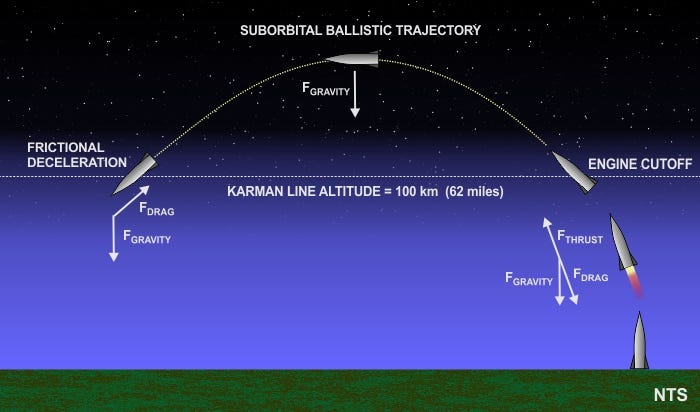
Image credit: Sky-Lights.org – “Suborbital Weightlessness”.
Altitude Range: ~100–150 km
Use Cases: Microgravity research, technology validation, educational payloads, propulsion testing
Analogy (Why This Orbit Works): Like tossing a ball straight up into the air, it briefly floats in weightlessness before falling back down. Ideal for short-duration experiments without committing to full orbital velocity.
Example Missions: PLD Miura 1, Blue Origin New Shepard, Virgin Galactic VSS Unity
VLEO (Very Low Earth Orbit)
Altitude Range: ~160–300 km
Use Cases: Ultra-high-resolution Earth observation, low-latency communications, atmospheric research, drag-assisted deorbiting
Analogy (Why This Orbit Works): Like flying a reconnaissance plane just above the treetops, you get unmatched detail, but you’re fighting air resistance the whole way. Perfect for sharp imaging and responsive coverage, but hardware must endure constant atmospheric drag.
Example Missions: ESA GOCE (gravity field mapping), Albedo (planned), LeoLabs (tracking debris in VLEO)
LEO (Low Earth Orbit)
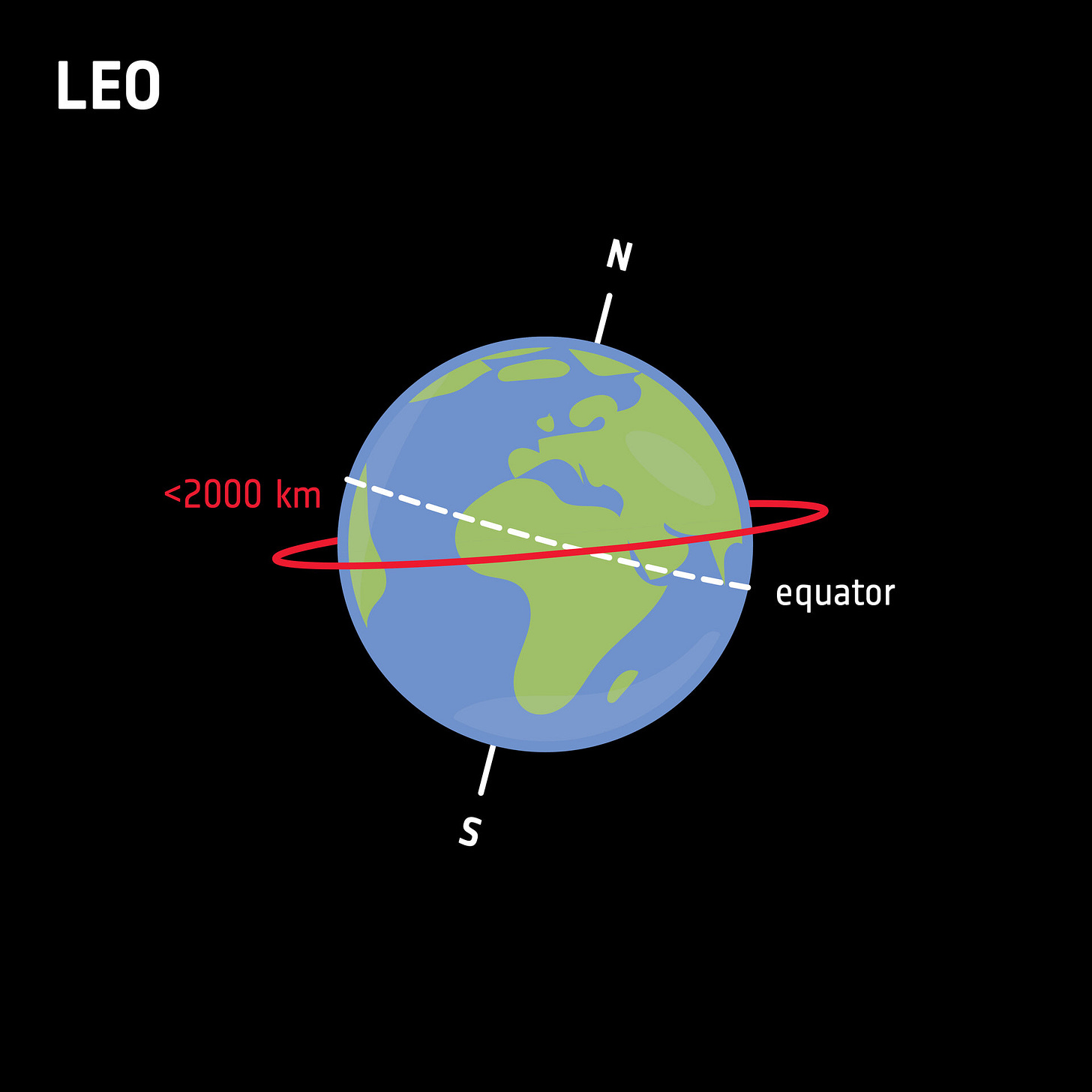
Image credit: ESA – “Low Earth Orbit” illustration.
Altitude Range: ~160–2,000 km
Use Cases: Earth observation (EO), IoT networks, communications, smallsat constellations, crewed missions (e.g., ISS)
Analogy (Why This Orbit Works): Like commercial jets constantly circling Earth, close enough for fast data transmission, frequent coverage, and minimal delay. Ideal for imaging, broadband, and real-time applications.
Example Missions: Starlink (SpaceX), OneWeb, International Space Station (ISS)
SSO (Sun-Synchronous Orbit)
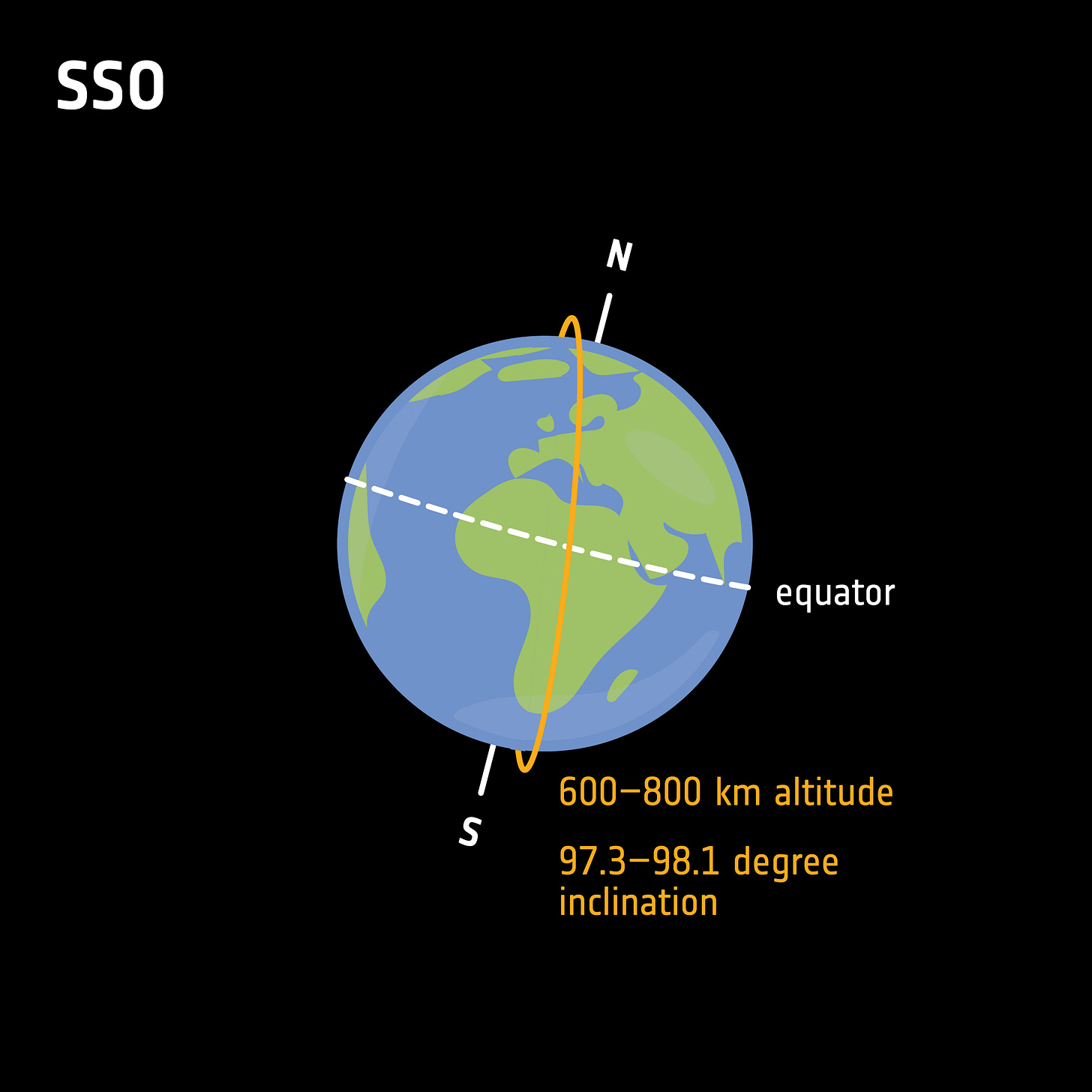
Image credit: ESA – “Polar and Sun-synchronous Orbit” illustration.
Altitude Range: ~600–800 km (a subset of LEO)
Use Cases: Earth observation missions requiring consistent lighting and repeatable imaging conditions
Analogy (Why This Orbit Works): Like a satellite taking the same photo at the same time every day, as if it’s following the Sun in lockstep. Ideal for tracking environmental changes, crop health, or urban development with consistent shadows and lighting.
Example Missions: PlanetScope (Planet), ICEYE, GHGSat
MEO (Medium Earth Orbit)

Image credit: SES – “The Power of Medium Earth Orbit (MEO) Satellites”.
Altitude Range: ~2,000–35,000 km
Use Cases: Global navigation satellite systems (GNSS), some communications
Analogy (Why This Orbit Works): Like positioning a relay tower halfway between cities, high enough for broad global coverage, but low enough to keep latency manageable. It’s the “Goldilocks Zone” of orbits: not too near, not too far.
Example Missions: GPS (USA), Galileo (EU), BeiDou (China), GLONASS (Russia)
GEO (Geostationary Orbit)
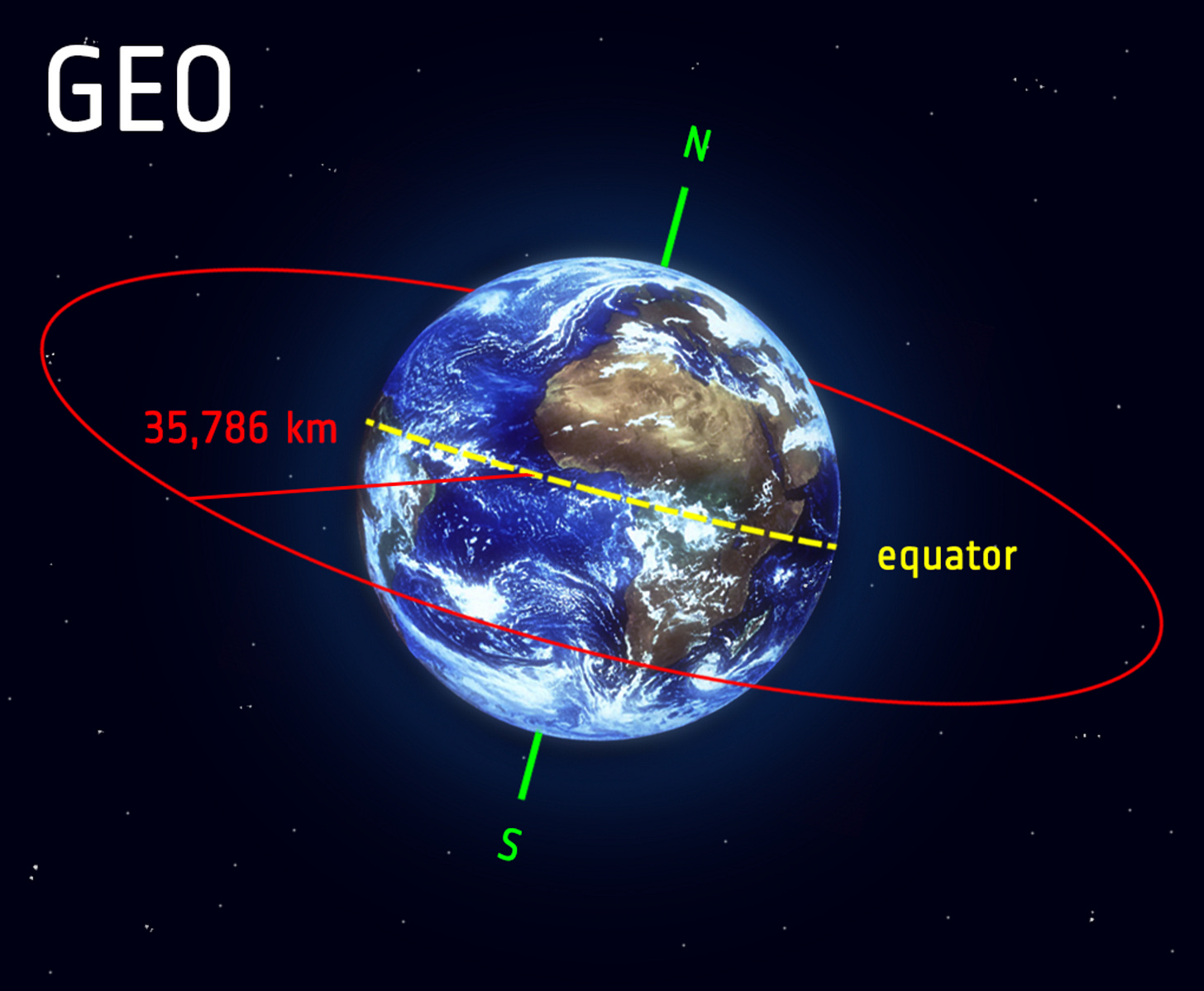
Image credit: eoPortal – “Meteorology and Geostationary Orbits”.
Altitude Range: ~35,786 km
Use Cases: Telecommunications, weather forecasting, disaster monitoring, satellite TV
Analogy (Why This Orbit Works): Like mounting a surveillance camera on a perfectly synchronised spinning globe, it stays fixed over one point on Earth’s surface. Ideal for uninterrupted coverage of large regions, such as entire continents.
Example Missions: GOES (NOAA), Inmarsat, Himawari (JMA)
GTO (Geostationary Transfer Orbit)
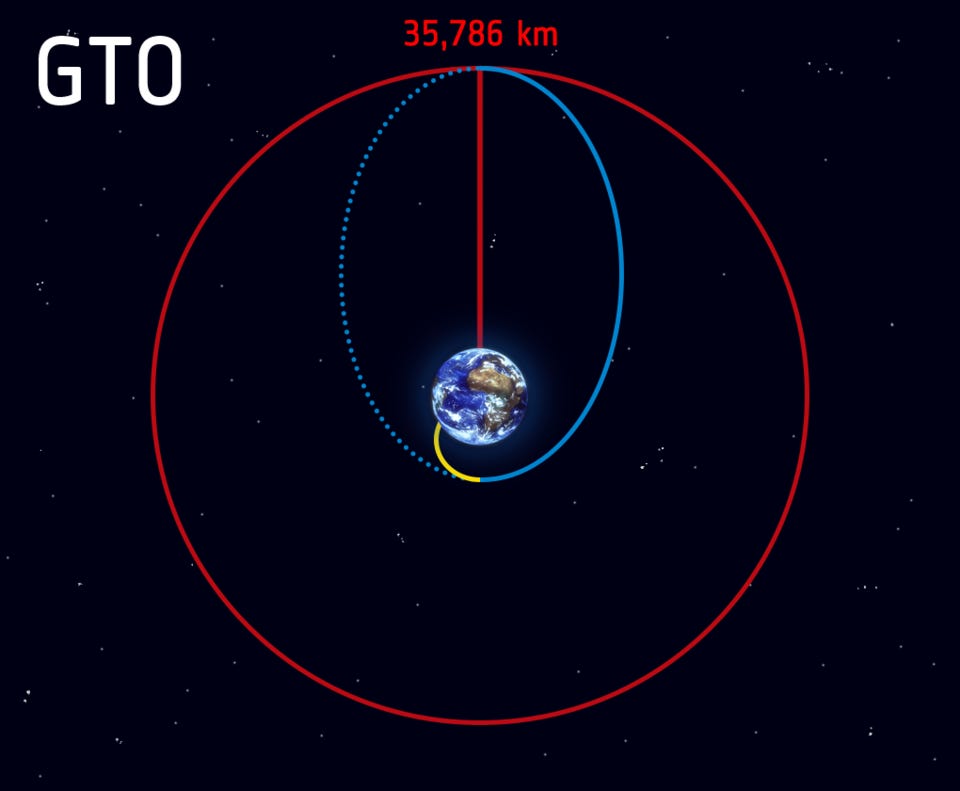
Image credit: Insights on India – “Transfer Orbits and Geostationary Transfer Orbit (GTO)”.
Altitude Range: Elliptical transfer orbit (~200 km perigee to ~35,786 km apogee)
Use Cases: Intermediate step for satellites heading to Geostationary Orbit (GEO)
Analogy (Why This Orbit Works): Like riding an escalator partway up a skyscraper before taking the elevator the rest of the way. efficient and cost-effective for launching heavy payloads to high altitudes.
Example Missions: Most commercial telecom satellite launches (e.g., SES, Intelsat, ViaSat)
Understanding orbits is essential because each orbit serves a unique commercial or scientific function.
The Newspace Players: A Taxonomy of Launch Providers
The modern space launch ecosystem is far more diverse than most people assume. Here's a simplified taxonomy:
A. Suborbital Launch Vehicles
Examples: PLD Space Miura 1, Blue Origin New Shepard, Virgin Galactic VSS Unity, Exos Aerospace SARGE, UP Aerospace SpaceLoft XL
Use Cases:
Microgravity and suborbital science experiments
Propulsion system validation and reusability trials
Educational and payload testing missions
Crew training and space tourism (e.g., Virgin Galactic)
Strategic Role: These vehicles serve as critical testbeds for technology demonstration, human spaceflight training, and early-stage revenue for NewSpace entrants aiming to build orbital heritage.
B. Small-Lift Orbital Launchers (<2,000 kg to LEO)
Examples: Rocket Lab Electron, Isar Aerospace Spectrum, RFA One, Firefly Alpha, ABL RS1, Astra Rocket 3 / 4, Orbex Prime, Phantom Space Daytona, Skyrora XL, Galactic Energy Ceres-1
Use Cases:
Launching Earth observation and IoT constellations
Academic and CubeSat payloads
Tech validation for emerging satellite platforms
Sovereign space access for small and mid-sized nations
Strategic Role: The backbone of NewSpace growth. These vehicles offer lower-cost, higher-frequency access to orbit and often compete on responsiveness, geographic flexibility, and customization rather than sheer mass or price.
C. Medium- to Heavy-Lift Launchers (~2,000–20,000+ kg to LEO)
Examples: SpaceX Falcon 9, Arianespace Ariane 5/6, ULA Vulcan Centaur, Relativity Space Terran R, Gilmour Space Eris (upcoming), India’s GSLV Mk III, Korea’s Nuri, China’s Long March 5, Japan’s H3
Use Cases:
Large commercial and government satellites
GTO telecom and military payloads
Science missions (e.g., telescopes, space probes)
Rideshare launches for diverse payloads
Human-rated systems and cargo to LEO (e.g., ISS resupply)
Strategic Role: These vehicles typically provide the best balance of cost per kilogram and mission reliability, often used by national programs or major constellations. Many are legacy systems or government-backed.
D. Mega-Lift & Crewed Deep Space Vehicles
Examples: SpaceX Starship, NASA Space Launch System (SLS), Blue Origin New Glenn, CNSA Long March 9, ISRO Next-Gen Launch Vehicle, Roscosmos Yenisei (planned)
Use Cases:
Crewed missions to the Moon, Mars, and beyond
High-mass interplanetary probes
National prestige and geopolitical demonstration
Future orbital infrastructure deployment (e.g., space stations, fuel depots)
Strategic Role: These vehicles represent the cutting edge of aspiration and risk in space transportation. They are symbols of national capability and are likely to redefine the economics of heavy-lift in the 2030s.
Each category reflects not just technical capacity, but also market positioning. For example:
Miura 5 isn’t built to challenge Falcon 9; it’s designed for regional customers requiring sovereignty, flexible orbits, and responsive timelines.
SpaceX rideshare may offer price advantages, but lacks the customisation that small clients may need.
Companies like Rocket Lab and Isar offer a middle ground: low cost, growing heritage, and increasing autonomy.
Sovereignty and Strategy: Why Geography Matters
Where a rocket launches from isn’t just a logistical decision. It’s a geopolitical one.
European customers, for example, may prefer Kourou or emerging Spanish launch sites to sidestep U.S.-based ITAR (International Traffic in Arms Regulations) constraints. But geography impacts far more than compliance. It shapes:
Regulatory jurisdiction
Insurance and liability exposure
Mission scheduling and launch cadence
In the post-Ukraine landscape, sovereign access to space is no longer just an economic advantage; it’s a matter of national security. Countries that once depended on Russian Soyuz rides are now racing to build homegrown or regional alternatives.
Governments are backing launch startups not merely as engines of innovation, but as instruments of resilience and strategic autonomy. Companies like PLD Space, RFA, and Isar Aerospace are more than just aerospace ventures. They are becoming cornerstones of a new era of sovereign infrastructure.
And this trend isn’t limited to Europe. Emerging players in Southeast Asia, like Singapore’s Equatorial Space Systems, are exploring launch capabilities from equatorial latitudes, leveraging favourable orbital dynamics and a drive for regional access to space. Even small nations are beginning to treat launch infrastructure as a strategic asset.
The Real Product: Trust, Heritage, and Cost
In the end, launch isn’t just about thrust—it’s about trust. And trust is earned through two key ingredients: heritage and cost credibility.
Heritage refers to a company’s track record. Has the rocket flown before? Has it recovered a payload successfully? Has it demonstrated reliability across multiple missions? Space is hard, and clients rarely want to be the first—or even second—payload on an unproven vehicle.
A company with heritage can:
Offer lower insurance premiums to customers
Close deals faster due to perceived reliability
Command a premium in strategic contracts
Even a single successful launch dramatically changes customer confidence.
Cost, meanwhile, isn’t just about the sticker price. The real cost of launch includes:
Delays and schedule slips
Orbital mismatches or ride-along compromises
Integration complexity and hidden engineering hours
Post-launch support and telemetry access
A $5 million launch that meets your orbit, timing, and customer service needs may be far more valuable than a $1 million launch with a two-year delay and no customer support. In that sense, launch pricing is more like enterprise software than shipping containers. Value lies in the customisation and service, not just the throughput.
The best launch providers behave like partners, not vendors. They help navigate the complexity of space access—not just physically, but legally, commercially, and strategically.
What About Newspace Launchers With No Heritage?
In a sector where failure can mean millions in losses, why would anyone trust a startup with their payload? Yet this is the exact paradox that newspace launch startups must confront: **You need heritage to win customers, but you need customers to build heritage.**
This challenge mirrors a classic trust dilemma in technology markets—but with much higher stakes. Unlike app startups, rocket companies can't afford beta versions in the wild. Their first real demo *is* the product.
Here’s how next-gen launch operators are tackling this Catch-22:
A. De-risking Through Suborbital Success
Before committing to orbital launches, some companies (e.g., PLD, Blue Origin) have conducted multiple suborbital flights. These missions validate propulsion, guidance, recovery, and more, while giving customers and regulators a glimpse of credibility.
B. Targeting Sovereign Gaps and Strategic Niches
Emerging players often focus on regional sovereignty. For instance, HyImpulse and ISAR are positioned to reduce Europe's dependency on the US and Russia. Companies in Brazil, India, and Japan pursue similar strategies to enable local access to space.
C. Locking In Anchor Customers Early
Partnerships with government space agencies, university payloads, or climate missions can be a powerful signal of trust. These early contracts may be subsidised, milestone-driven, or involve technical assistance, but they help cross the credibility chasm.
D. Over-Engineering First Flights
Newspace players may deliberately over-design their maiden vehicles to increase the probability of success. This includes extra propulsion margin, conservative guidance algorithms, or longer integration timelines.
E. Strategic Patience
Startups like ABL and Orbex have chosen delayed but rigorous launch attempts over rapid cycles. In space, a slower, successful debut beats a fast, fiery one. Each successful milestone builds compounding trust.
F. Vertical Integration and Ecosystem Control
Some companies, like Rocket Lab, control both the launcher and payload integration process, offering smoother workflows and fewer failure points. This approach accelerates feedback loops and protects reputation.
Conclusion: Launch as Strategic Infrastructure
Launch isn't a moonshot. It's infrastructure. And like all infrastructure, it's invisible when it works, and catastrophically visible when it doesn't.
What makes a good launch provider in the newspace era isn’t just performance or pricing. It’s how well they understand launch as a service layer between Earth and orbit, as a geopolitical asset, and as a trust-based relationship with payload customers.
So the next time someone says, “We just need a launch,” you’ll know to ask: To where? With what? From whom? And why?
Because in space, how you get there changes everything.


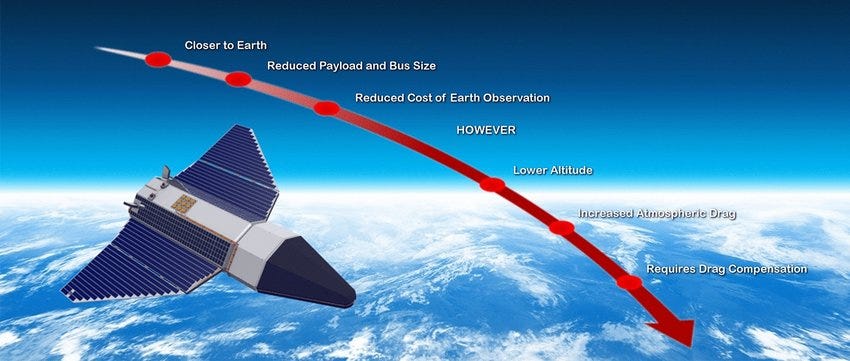
Loved reading this, Gemma! You covered out all so well while keeping it simple!